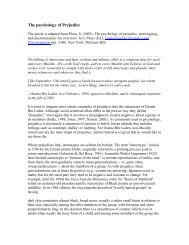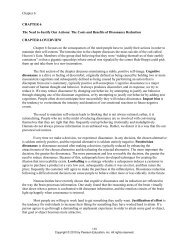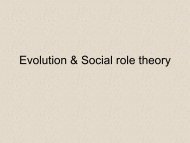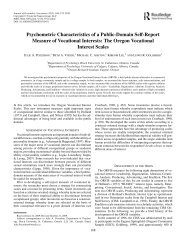Attitudes and Attitude Change CHAPTER 7 Attitudes and Attitude ...
Attitudes and Attitude Change CHAPTER 7 Attitudes and Attitude ...
Attitudes and Attitude Change CHAPTER 7 Attitudes and Attitude ...
Create successful ePaper yourself
Turn your PDF publications into a flip-book with our unique Google optimized e-Paper software.
168<br />
Copyright © 2010 by Pearson Education, inc. All rights reserved.<br />
<strong><strong>Attitude</strong>s</strong> <strong>and</strong> <strong>Attitude</strong> <strong>Change</strong><br />
the association between an object <strong>and</strong> an evaluation of it, which is typically measured by the speed with<br />
which people can report how they feel about an issue or object. The best-known theory of how attitudes<br />
predict deliberate behaviors is the theory of planned behavior. According to this theory, when people<br />
have time to contemplate how they are going to behave, the best predictor of their behavior is their<br />
intention, which is determined by three things: their attitudes toward the specific behavior, their<br />
subjective norms, <strong>and</strong> their perceived behavioral control.<br />
The final section of the chapter discusses the power of advertising. Most people think that<br />
advertising works on everyone but themselves. People are influenced by advertisements more than they<br />
think. If advertisers are trying to change an affectively based attitude, then it is best to fight emotions with<br />
emotions. If people’s attitudes are more cognitively based, we need to ask an additional question: How<br />
personally relevant is the issue? If you are dealing with a cognitively based attitude that is not of direct<br />
personal relevance, you might succeed in changing their attitudes via the peripheral route, but this type of<br />
attitude change tends not to be long-lasting. The trick here is to make your product personally relevant.<br />
Many advertisements also try to make people’s attitudes more affectively based by associating the<br />
product with important emotions <strong>and</strong> values.<br />
Subliminal messages are words or pictures that are not consciously perceived but may<br />
nevertheless influence people’s judgments, attitudes, <strong>and</strong> behaviors. Subliminal messages can be auditory<br />
as well. There is no evidence that the types of subliminal messages encountered in everyday life have any<br />
influence on people’s behavior. There is evidence for subliminal effects in carefully controlled laboratory<br />
studies. To get subliminal effects, researchers have to make sure that the illumination of the room is just<br />
right, that people are seated just the right distance from a viewing screen, <strong>and</strong> that nothing else is<br />
occurring to distract them as the subliminal stimuli are flashed. Even in the laboratory, there is no<br />
evidence that subliminal messages can get people to act counter to their wishes, values, or personalities.<br />
Ads are more powerful when people consciously perceive them. Advertising influences more<br />
than just our consumer attitudes. Advertisements transmit cultural stereotypes in their words <strong>and</strong> images,<br />
subtly linking products with desired images. Gender stereotypes are particularly pervasive in advertising<br />
imagery. The stereotypes conveyed in advertisements are far from harmless. The media can have<br />
powerful effects on people's attitudes, both directly <strong>and</strong> indirectly.<br />
<strong>CHAPTER</strong> 7 OUTLINE<br />
I. The Nature <strong>and</strong> Origin of <strong><strong>Attitude</strong>s</strong><br />
• Social psychologists define an attitude as an enduring evaluation, positive or negative, of people,<br />
objects, or ideas.<br />
A. Where Do <strong><strong>Attitude</strong>s</strong> Come From?<br />
• Tesser (1993) suggests that some attitudes are linked to our genes. Evidence for this is based on the<br />
finding that identical twins raised apart (<strong>and</strong> not knowing of each other) have more similar attitudes to<br />
each other than do fraternal twins. <strong>Attitude</strong> similarity is probably mediated indirectly by similarity of<br />
temperament <strong>and</strong> personality.<br />
• Even if there is a genetic component, social experience clearly plays a large role in shaping<br />
attitudes.<br />
• Although all attitudes have the three components, any given attitude can be based more on one<br />
component than another.

















